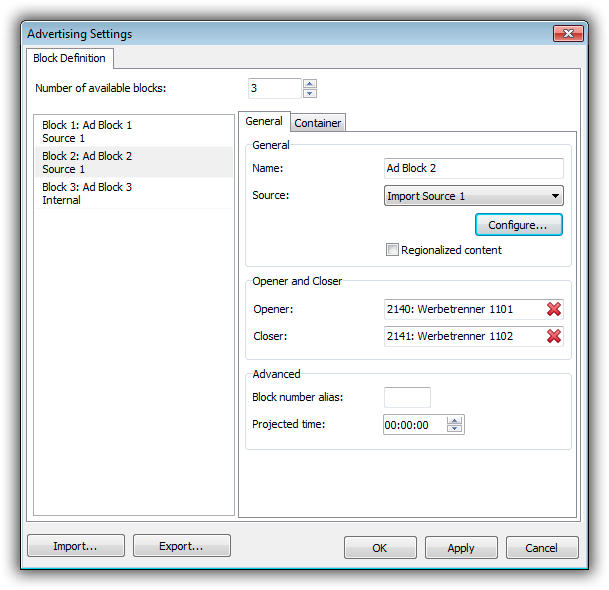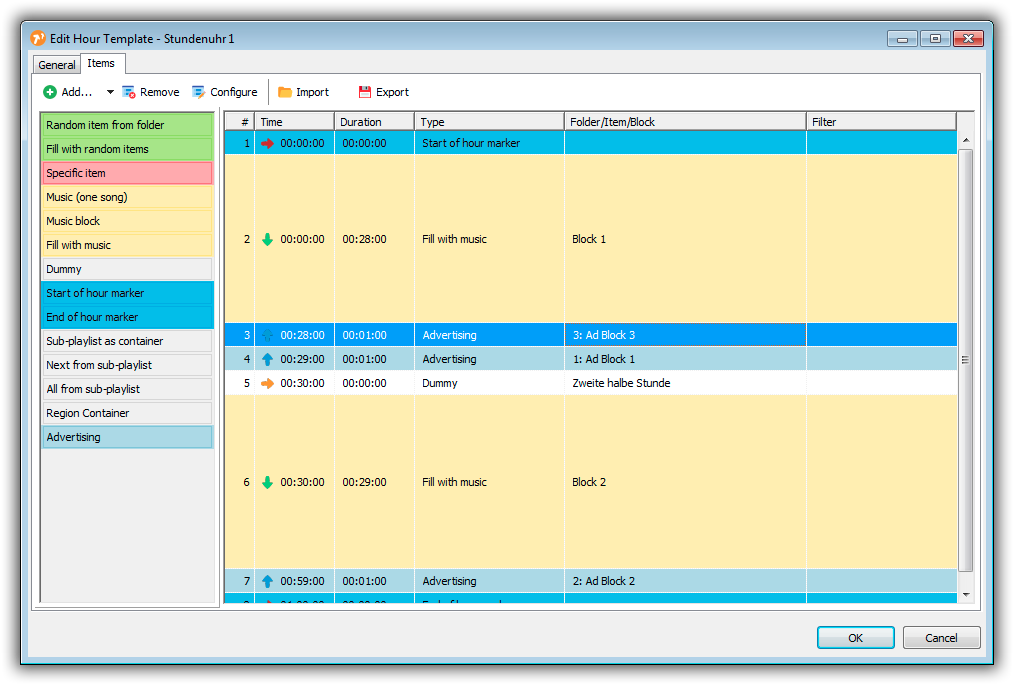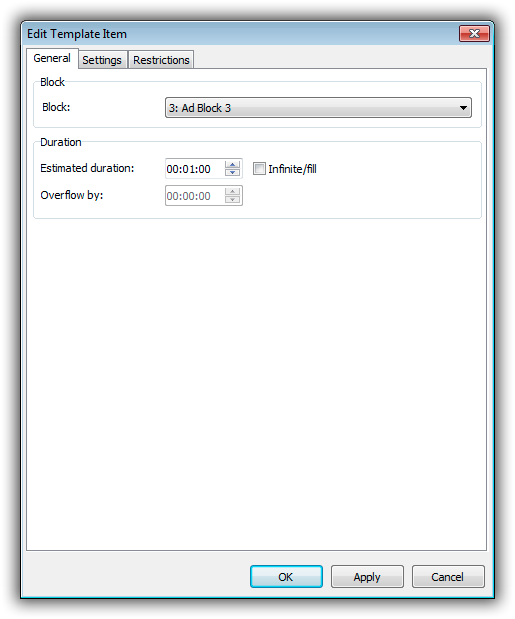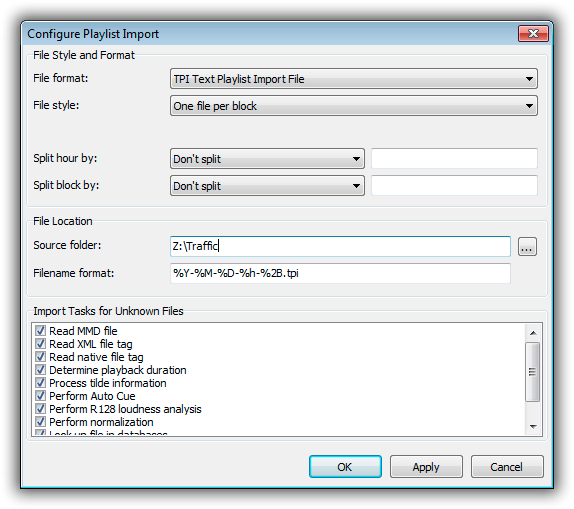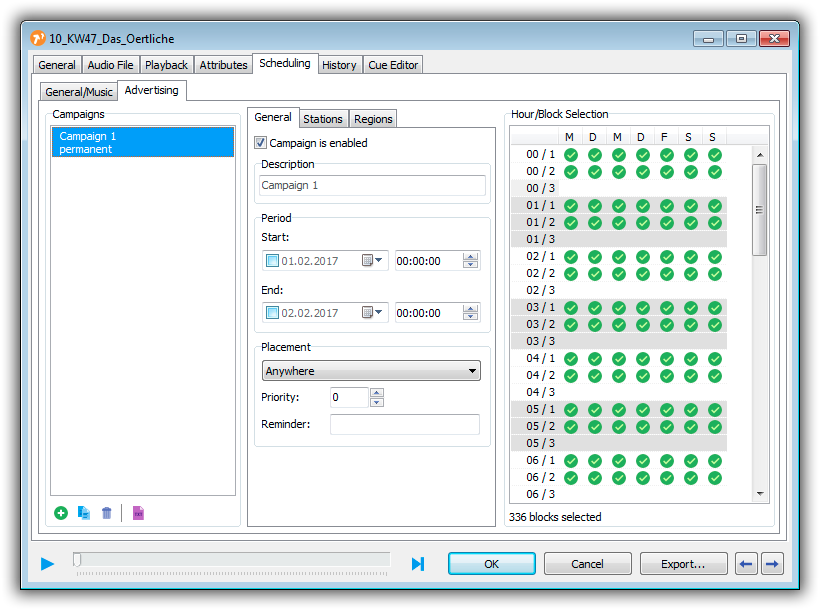Table of Contents
Advertising Scheduling in mAirListDB
This article explains how to use advertising scheduling in mAirListDB, either by importing traffic logs from external software, or buy using the (simple) built-in scheduler.
Advertising will be scheduled using the Mini Scheduler, so we assume that you have followed the Music Scheduling tutorial, and have hour templates set up as as required. At that point, you will be able to add advertising breaks to your hourly schedule.
Advertising Block Setup
Defining the blocks
The first step is to decide about the (maximum) number of advertising blocks/breaks you will have per hour, and set up the block accordingly. Open the mAirListDB app and go to Administration → Advertising Setup, which will bring up the following dialog:
First, adjust the number of available blocks (per hour) as required. We currently support up to 16 blocks per hour, which should be more than enough for most purposes.
Thereafter, select a block from the list on the left, then edit its properties:
- On the General tab:
- The Name of the block; it will appear in the scheduler dialogs, and is also being used as default for the title of the resulting container playlist item.
- The Source can either be the internal scheduler, or one of up to 8 different file import sources (when working with external scheduler). We will describe both methods below. Note that you can set the source individually for each block, so you can actually mix internal and external scheduling within one hour (e.g. use internal scheduling for promos, and external scheduling for the actual advertising).
- The Regionalized content option is only relevant for import sources; it will create Region Containers by importing multiple traffic logs, or for each region, at the same time. See comments below.
- If required, specify an Opener and Closer item that will be played at the beginning and end, respectively, of this ad block.
- The Block number alias can be used to tweak import filenames, see below.
- The Projected time setting is used when exporting campaign information for the internal scheduler, see below. You can set it to the minutes/seconds of the hour when the block is usually played.
- On the Container tab:
- When Always create a container is enabled, the Mini Scheduler will always use a container to wrap the items of the ad block, rather than adding them individually into the playlist, even if not explicitly requested by the hour template item. This option must be turned on if you are going to use the Update Advertising function.
- You can also adjust the Title, Artist, Type and Color to be used for the container playlist ist.
Once you have set up all blocks as required, you can continue to add them to your hour templates.
Adding advertising to the hour templates
Go to Administration → Manage Templates and edit your hour templates. In the list of the available template items on the left, you will see one named Advertising. Drag one or more of these into the desired positions:
Double-click each item, and select the corresponding block (see above) for this ad break:
We strongly recommend that you use containers for all advertising blocks; but rather than setting the container options on the Settings tab in this dialog, you should check the Always use a container option the advertising block setup (see above), to make the Update Advertising function work.
Once you have added the ad blocks to your hour templates, you can re-run scheduling to create new playlists with the ad blocks included. They will initially be empty - now it's time to fill them with content.
Importing Traffic Logs
mAirList can import most traffic logs created by external software, given that they are available in one of the playlist format that mAirList understands. We encourage you to use mAirList's Text Playlist Import (TPI) format when available, but any other format like M3U will do as well.
To set up a block for import, edit the block in the Advertising Settings dialog, set its source to e.g. Source 1, and click Configure to set up the import file location and format:
In the above example, we use TPI-style files, with a separate file per block, all located in the same folder, and named <Year>-<Month>-<Day>-<Block Number>.tpi.
Some useful notes:
- Use
%Bas a placeholder for the block number, or%2Bor%3Bfor zero-padded to length two or three. - If an alias was set, it will be used for the
%Bvariables instead of the internal block number. This is for schedulers that use the projected minute as the block number, e.g. xx20 for the 00:20:00 block (which may be block no. 1 in mAirList), and xx50 for the 00:50:00 block (possibly block no. 2 in mAirList). - When using multiple regions, the region number can be accessed with
%N,%2N, or%3N. Region numbers are 1-based. The Regionalized content option must be enabled in the block configuration. - Whenever possible, we recomment to use a separate file per block; automatic splitting is also available, but separate file are much more reliable. With TPI, you can also use a single file with block number indicators (B-lines) in between the block contents.
Using the Built-In Scheduler
mAirListDB has a very simple advertising scheduler built in that can be used to schedule spots based on campaigns and hour/blocks selected by the users.
To use a spot with the internal scheduler, edit its properties in the DB library, go the Scheduling tab, and to the Advertising sub-tab:
First, you must add a new campaign. A campaign is a period of time in which the spot is going to be broadcasted. It can have a start and/or end date, or start instantly and run indefinitely. You can set up multiple campaigns at the same time, and also disable running campaigns temporarily. Spots can be filtered by campaign in the DB Library tree.
You can devide about the placement of the spot within the block: anywhere, towards the beginning or towards the end. This can be fine-tuned by setting the priority value accordingly. You can also specify another spot that is used as the reminder, i.e. that is added at the end of the ad block whenever the current spot is being used.
If you are using multiple stations and/or regions, select them as required.
In the Hour/Block Selection grid, check the days/hours/blocks where the spot should be used. You must do so manually (this is where mAirList is different from a full-featured advertising scheduler), but it is possible to save/restore often used assignments using the right click menu.
Hint: Click a column header to toggle all blocks for the entire day; click a row header to toggle all days for that block; shift+click a row header to toggle the same block for all hours of the day.
Using the "Update Advertising" Function
Advertising blocks are created (and filled with content) at the time that you run the scheduling for the particular hours.
But it can often happen that the advertising content changes later. For example when there is a last-minute booking or cancellation. Or if the scheduling is performed long before the traffic logs are available.
For that reason, mAirList includes an Update Advertising function that will redo the advertising scheduling for the selected hours, and update the playlists accordingly.
You must enable the Always use container option in the ad block settings to make Update Advertising work. Without that option, and the containers, mAirList will not be able to identify the start end end of the ad blocks within the hourly playlist.
The Update Advertising function is available in various places:
- In the menu next to the Generate button the mAirListDB playlist view - will update the currently loaded playlist.
- In the right-click menu of the Go to dialog - can update multiple hours at once.
- In the options for the (append/load/play) database playlist actions in the Event Scheduler, so you can perform it automatically during the hourly playlist load event.
- In the right-click menu of the playlist in the playout window - to allow last minute changes.
